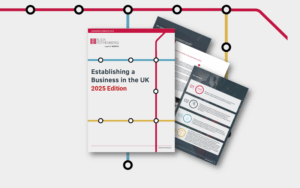2022 year-end tax planning: 8 top tips
We look at some of the tax planning opportunities available to Americans based in the UK, together with some key dates for your diaries
With rising inflation, interest rates and a strong US dollar, 2022 has been an eventful year. Therefore, it’s a good time to think about the planning opportunities that may still be available to you before the end of the year. While there will be some low hanging fruit which you may already be familiar with, it’s important to also consider some of the more complex tax planning opportunities which could apply to your situation. So, what can you be doing now to optimise your global tax position? Here are eight of our top tips for your consideration.
1. Get on top of your foreign tax credits
If you claim foreign tax credits on a paid basis, you may be required to accelerate your UK (or other foreign country) tax payment into the current calendar year. Concentrating on the UK, the tax due here on untaxed 2022 income and gains will most likely be payable after the end of the 2022 calendar year. So, by making this payment in December 2022 instead, you can ensure that this tax credit is available to offset any 2022 US tax that would otherwise be due.
Is this relevant to you?
This is typically relevant if you are:
- a self-employed individual
- a partner in a partnership
- an arising basis taxpayer
- an individual becoming ‘deemed domiciled’ in the UK
- an individual with significant one-off transactions in 2022, such as a capital gain, carried interest payment or remittance to the UK
However, it is less relevant if you are in receipt of employment income only, on which taxes are typically correctly withheld at source.
An important point to note here is that the US/UK Income Tax treaty needs to be reviewed, to determine which jurisdiction has the primary taxing right on the specific income in question. If you are a US taxpayer resident in the UK, the UK is awarded that right on most types of investment income, excluding US real estate and a portion of US dividend income.
With a strong US dollar, one-off transactions and their associated UK tax will need to be calculated with the exchange rates at the time.
For the avoidance of any doubt, if you claim foreign tax credits on the accrued basis, the above will not apply to your situation.
2. Double-check charitable donations
For a charitable donation to be deductible in the 2022 tax year, it must be paid within 2022. This applies to donations being made in both cash and via other property.
It is always worth exploring non-cash methods of donation that may help you achieve your aims. For example, the ability to donate shares instead of cash can be overlooked. Appreciated stock can be donated to charity, with the fair market value of the stock generally equating to the deemed donation value.
What is more, the Capital Gains Tax on the ‘sale’ will not apply when the charity later sells the stock, so this represents a very clear double tax saving.
There are also specialist donor-advised funds available which exist to enable both a US and UK tax deduction on your charitable donations. However, a fee is often payable for these services, so these should only be considered when looking to make larger donations.
Many large US universities and investment houses can offer similar dual-qualifying structures, so the next time you are considering a donation, it might be worth asking the charity if they have such a structure in place, because they may not be aware of your status as a US and UK taxpayer.
3. Itemised deductions vs the standard deduction
It is important to remember that the standard deduction has increased significantly in recent years. For 2022, the standard deduction for single taxpayers and those married but filing separately is $12,950. Married couples who file a joint return will be entitled to a standard deduction of $25,900.
With this in mind, and depending on the amounts involved, some taxpayers who have claimed itemised deductions historically, including charitable donations, may now be better off simply claiming the standard deduction instead.
Making the choice between an itemised deduction and the standard deduction is something that you can do each year. This could make it more efficient to carry out one-off larger charitable donations every few years, rather than smaller annual payments.
4. Releasing unrealised losses
With major stock markets down during 2022, it is worth considering utilising any unrealised capital losses to offset capital gains. In most circumstances, capital losses cannot be carried back to earlier years, so by realising losses in the same year as gains, you can achieve a noticeable tax saving.
Note that the ‘matching’ of losses to gains is not necessarily required and so you do not need to realise short term losses to offset short-term gains. If your capital losses exceed your capital gains, the excess can be deducted on your tax return and used to reduce other income (up to an annual limit of $3,000, or $1,500 if you are married but filing separately).
If your capital losses for the year exceed your capital gains after the deductible amount, the remaining loss is carried forward indefinitely for use against future capital gains.
This year, in particular, you need to consider foreign exchange rates when calculating current year capital gains and realising any capital losses. With such big fluctuations, you want to avoid any nasty surprises.
5. Foreign mortgage refinancing
With increasing interest rates, you may be considering refinancing your mortgage. If this is a UK pound mortgage, as the US dollar has strengthened, you may have US taxable income. This is because you are considered to be paying back less US dollars than you originally borrowed when the foreign exchange rate got you more US dollars for your pound.
The benefits of refinancing and possible interest rate savings may outweigh any negative US tax consequences, but you should take advice to see if this tax can be mitigated and avoid surprises.
6. Consider State and Local Taxes
Despite continued debate in Washington about the deduction for State and Local Taxes, the restriction remains in place for 2022 and taxpayers can only claim up to $10,000 of State and Local Taxes as an itemised deduction.
Bearing this in mind, it is worth giving some thought as to whether a benefit can still be derived from accelerating those quarter four (Q4) estimated State tax payments. The decision on whether to do so should be informed by the wider context of claiming itemised deductions or the standard deduction, so it may be worth speaking to your adviser about this.
7. Feeling generous?
The gift tax annual exclusion for 2022 is $16,000. This means you can generally gift up to $16,000 in the tax year to any number of people without those gifts being taxable. For married taxpayers who are splitting gifts, the exclusion for 2022 is $32,000.
You are also able to give unlimited amounts towards tuition or medical expenses if you pay the provider directly.
Beyond the annual exclusion, the lifetime gift and estate tax exemption will apply – sometimes referred to as the unified credit. For 2022, the amount is an inflation adjusted $12.06m, which may allow small additional non-taxable gifts to be made by those who have previously exceeded their lifetime limit.
Use of the unified credit during your lifetime will of course reduce the exemption available on death.
The annual gift limit to a non-US spouse has also been increased to $164,000 for 2022.
For 2023, the annual gift exclusion is $17,000 and the amount to a non-US spouse is $175,000. The unified credit will also rise to $12.92m for 2023.
8. Life after retirement
There is still time to make contributions to your retirement plan for the 2022 tax year. For those under 50 years of age, the amount you can contribute to a Traditional Individual Retirement Account (IRA) or Roth IRA sits at $6,000 for 2022 – the same limit applied for 2021.
The maximum 2022 contribution to a 401(k) plan is $20,500. Again, this applies to those under 50.
To maximise your tax-deferred savings, you may wish to discuss with your financial advisor whether fees levied by your pension provider can be met using assets held outside of the plan.
Would you like to know more?
If you are unsure about how any of the above might apply to you, please get in touch with your usual Blick Rothenberg contact or Alex Straight using the form below.
Contact Alex

You may also be interested in

Is the End of the Triple Lock Pension Inevitable?

The UK is a stable, open and innovation-driven market for Japanese firms to invest in













